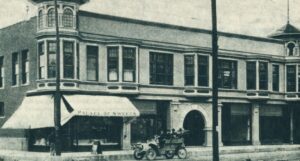Downtown Pekin’s historic Arcade Building, located at 15 S. Capitol St. across from the Tazewell County Courthouse, has been on the minds of many in recent weeks and months. One reason is because the Tazewell County Museum recently has completed the transfer of its collections and operations from its former Sunset Plaza location to the Arcade Building.
But this structure also has been the subject of discussions regarding whether or not the Arcade Building will have a future in the long term, after inspections found the building to be in great need of repairs to its foundation. The building is county-owned, and the county recently agreed to provide the repairs, rather than condemn and demolish it – so the Arcade Building will remain a fixture of Pekin’s downtown for years to come.
Over the course of the 110 years of its existence, the Arcade Building has seen a lengthy list of tenants come and go. Until closing its doors not very long ago, perhaps the most popular tenant – especially for county workers on lunch hour – was the Courtyard Café. The space next to that, on the south end of the building, has hosted numerous tenants over the decades, from the Palace of Sweets in the early 20th century, to the Will Harms Co. in the 1960s, to Radio Shack around 1970.
Several volumes in the Pekin Public Library’s Local History Room collection can help us trace the history of the Arcade Building. For example, Rob Clifton says in his “Pekin History: Then and Now” (2004), “Built in 1905 the Arcade building was to house a new theater. The theater never panned out but many businesses have occupied the space.” Clifton also discusses a store that once occupied the building’s center space under the arch, where shoe shines were once offered.
The 1974 Pekin Sesquicentennial volume, on pages 52-54, tells of local realtor Robert B. Monge’s restoration work after he had acquired the Arcade Building.
“In the spring of 1946,” the Sesquicentennial says, “Robert and his brother, Emile B. Monge, Sr., started their business by building four houses. Approximately 30 homes were built within the next three years, and then the two brothers entered the subdivision business and developed Lawndale Subdivision in 1949 and 1950. There they established their first office, which served the business with several additions until December of 1971, when they moved downtown into the Arcade Building. It has since been extensively restored as a sample of Monge’s interest in the redevelopment of the downtown area.”
Monge had also sought to restore and revitalize the old Pekin Theater next door to the Arcade Building. Though his efforts to save the theater failed, he did save the Arcade Building.
An exhaustive list of all the businesses and tenants that have operated from the Arcade Building since 1905 would be several pages long, but following is the tally of the building’s tenants as shown in the 1908-09 Pekin City Directory (including the home addresses or residences of the business owners or staff):
- Black, Edward E., attorney, 235-237 Arcade bldg, r 1201 Bacon
- Cooney, Wm. B., attorney, suite 216-218 Arcade bldg, r 621 Hillyer
- Lawley, David F., attorney, Arcade bldg, r 614 Hillyer
- Wilkins, Frank, attorney, Arcade bldg, r 500 Elizabeth
- Nixon, Al, barber, Arcade bldg., r 1023 Catherine
- Brereton, C. L., Box Ball Alley, Arcade bldg, r 902 Park (“Box Ball” was a popular coin-operated arcade game in the early 20th century – based on bowling, the game was made of wood and somewhat resembled skee-ball.)
- Willett, R. C., dentist, rms 232-234 Arcade bldg., r 417 Haines
- American General Agency Co., Geo. L. Colburn pres, 217 Arcade bldg.
- Pioneer Life Insurance Co., Geo. L. Colburn pres; I. P. Mantz, sec, Arcade bldg.
- Buck, Chas. A., insurance agent, Arcade bldg., r 213 S. Second
- Peoria Journal, Abie Schaefer, mngr, Arcade bldg.
- Peoria Herald-Transcript, C. R. Barnes, representative, Arcade bldg.
- Coleman, John M., physician, Arcade bldg, r 349 St. Mary
Shown is a vintage photograph of the Arcade Building in downtown Pekin, taken apparently within the first 10 to 15 years after its construction in 1905.









